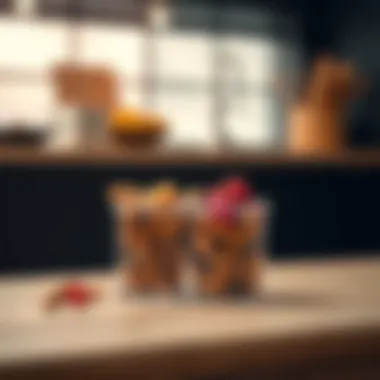Benefits of Two Compartment Snack Containers


Intro
In a world where snacking has grown increasingly popular, two compartment snack containers have crept into many homes and offices, making them a cornerstone of convenient meal organization. These nifty creations not only simplify the act of packing snacks but also promote healthier eating habits and encourage portion control. They serve as a versatile tool for various lifestyles, from busy professionals seeking quick meal solutions to parents striving to provide balanced options for their children.
The structure of food container choices can blur the lines between what is practical and what is simply fashionable. This article taps into the manifold benefits of two compartment containers, diving into material selections, size options, and how they measure up against traditional single compartment designs. By the end, readers will have a well-rounded perspective, guiding informed decisions that could positively impact personal health and organization in daily meal practices.
Considering our interaction with food prep, nobody wants to be caught without the right tools. Therefore, understanding the landscape of two compartment snack containers is essential. We'll explore how these containers have evolved, why they're practical, and how they can fit seamlessly into your life.
Let’s unravel the compelling reasons behind choosing these containers over their simpler counterparts.
Preamble to Two Compartment Snack Containers
In today's fast-paced world, where convenience often reigns supreme, the importance of efficient food storage cannot be overstated. Two compartment snack containers have emerged as a trendy, practical solution to meet the diverse needs of consumers keen on maintaining a healthy diet and organizing their meals effectively.
These containers can be particularly relevant for busy individuals struggling to balance work, family, and health. They provide a unique structure that allows users to portion snacks into separate categories, making it easier to display nutritional variety while keeping track of what and how much is being consumed.
Definition and Purpose
A two compartment snack container is essentially a versatile food storage option designed with two distinct sections. These compartments are typically sealed off from one another, thus allowing users to store different snacks—like carrots and hummus or yogurt and granola—without flavor contamination. The primary purpose of these containers is to promote smarter eating habits by encouraging the consumption of multiple food groups while providing visual appeal, as the contrasting colors and textures of various snacks can make meals more enticing. Furthermore, they support portion control, a vital aspect for those looking to manage weight effectively.
History and Evolution
The evolution of food storage solutions is quite fascinating. Snack containers haven’t always been as refined as we see them today. Initially, people would rely on plain, single-section containers, often resulting in soggy fruits or mixing of flavors. Over the years, as health-consciousness surged alongside a growing understanding of nutrition, manufacturers began designing more specialized products. Early models of two compartment containers appeared as simple lunch pails but have now morphed into sophisticated instruments made from a range of innovative materials. The modern container often boasts features like leak-proof seals and eco-friendly plastics, catering to both style and sustainability.
From basic designs that date back to the 1960s to today’s sleek, functional containers, it’s evident that two compartment snack containers have been refined through consumer feedback and nutritional trends. As they gain popularity, they accurately reflect a broader cultural shift toward conscious eating and convenient meal prep amid chaotic lifestyles.
Ultimately, understanding the utility of these containers can lead to informed choices that go beyond the purchase, positively influencing meal preparation, snack variety, and ultimately, dietary habits.
The Functional Design of Snack Containers
The world of snack containers has transformed significantly with the introduction of dual-compartment designs. The functional design of these containers not only elevates snack organization but also plays a pivotal role in promoting healthier eating habits. With the right container, snacking can become a more structured and enjoyable part of one’s daily routine.
Compartmentation for Preparedness
Compartmentation is at the heart of the utility of two-compartment snack containers. By dividing snacks into separate sections, users can prepare and portion out snacks in advance, which can be a game changer in today’s fast-paced environment. Imagine racing between errands or work meetings; pulling out a neatly organized compartment container means healthy snacking is always within reach.
One significant benefit of this design lies in its ability to encourage balanced eating. Consider a scenario where one compartment holds nuts and the other fresh fruit. This combination not only meets various nutritional needs but also keeps the taste buds satisfied. Plus, it’s a smart way to avoid excessive snacking on unhealthy options, as having everything neatly compartmentalized makes one less likely to fall off the bandwagon.
Moreover, the reasonable division helps with meal prepping. If you plan meals or snacks for the week ahead, having compartments encourages careful consideration of each food's nutritional value—making it easier to maintain a balanced diet throughout the week.
Materials Utilized
The materials used in the construction of snack containers greatly influence their functionality and user experience. With a spectrum of choices available, the most common materials are plastic and glass, each bringing its unique advantages and disadvantages to the table. Understanding these can help consumers make a better choice tailored to their needs.
Plastic vs. Glass
When it comes to the ongoing debate of plastic versus glass, each has its niche following, driven by specific users' preferences and needs. Plastic containers, for instance, are lightweight and virtually unbreakable, making them ideal for kids’ lunch boxes or for anyone on the move. They can handle bumps and drops without fear of shattering. On the flip side, they can retain some odors and stains, which can be a downside for those very particular about cleanliness.
In contrast, glass containers are often viewed as a more sophisticated option. They do not leach chemicals and are generally more aesthetically pleasing, which can matter in social settings. However, their weight and fragility can make them less practical for active lifestyles. Ultimately, the choice boils down to personal needs—whether durability or aesthetics takes precedence.
BPA-Free Considerations
BPA (bisphenol A) considerations have become increasingly relevant in today's health-conscious society. BPA is a chemical often found in various plastics and is known for its potential health hazards. Consequently, many consumers now look for BPA-free options when selecting snack containers. This characteristic not only prioritizes personal health but reflects a broader trend towards safer product choices.


A BPA-free container reassures buyers that harmful chemicals are absent, making it a healthier choice for long-term use. However, it’s crucial to note that just because a plastic is BPA-free, it doesn’t automatically mean it’s the best option. Many alternatives are not without their own shortcomings, often requiring careful evaluation to ensure genuine safety and usability.
Sustainable Alternatives
Finally, as the global conversation on sustainability continues to grow, many consumers are actively seeking sustainable alternatives for snack containers. This movement emphasizes eco-friendliness without compromising functionality. Bamboo, stainless steel, and silicon are some materials gaining traction.
Sustainable options not only cater to environmentally-conscious individuals but also arrive with a promise of durability. Many of these materials are free from harmful chemicals and are recyclable, aligning packaging with the greener choices many aspire to make. They offer a unique blend of style and environmental responsibility, making them an attractive choice within the broader snack container market.
In sum, the functional design of snack containers, especially the dual-compartment variant, satisfies multiple needs—organizing snacks for easy access, encouraging healthy eating habits, and adapting to diverse material preferences. It’s all about making informed decisions aligned with personal lifestyles and values.
Promoting Healthy Eating Habits
Healthy eating habits are crucial in today’s fast-paced world. Two compartment snack containers are not just practical; they also play an essential role in encouraging these habits. The act of snack preparation becomes simpler when the right container is used. With designated spaces, it allows for balance—combining different food groups in one handy package. When individuals choose to snack from neatly divided containers, they’re not just munching; they’re making smart dietary choices.
Convenience for Portion Control
Portion control is a significant factor in managing weight and health effectively. By design, two compartment snack containers make it easy to stick to recommended serving sizes. Instead of mindlessly grabbing a handful of snacks, users can easily measure out their portions. For example, if one half is filled with almonds and the other with carrot sticks, it’s easy to see how much energy-dense food one is consuming compared to fiber-rich vegetables. This visual separation reduces the temptation to overeat. Not only does this help in managing calorie intake, but it also fosters mindfulness while snacking—an aspect often overlooked in the hustle and bustle of life.
Diverse Snack Pairing Options
Combining Proteins and Fibers
Combining proteins and fibers within a two compartment container is a stellar choice for enhancing nutritional intake. Proteins, being the building blocks of life, are essential for muscle repair and growth. Fibers, on the other hand, aid digestion and keep you feeling full longer. This combination is not only beneficial but also satisfying. Picture a layout where one side holds edamame or Greek yogurt while the other has whole-grain crackers or mixed greens. This not only facilitates nutrient diversity but also caters to taste preferences, making healthy choices more appetizing.
Incorporation of Fruits and Vegetables
Incorporating fruits and vegetables into daily snacking routines plays a pivotal role in overall health. Two compartment snack containers offer an ideal arrangement for this. One section can be dedicated to fresh fruits like strawberries, while the other can hold colorful bell peppers or cucumber slices. This setup not only preserves their freshness but also makes these healthful options more convenient. Having a mix of vibrant produce can encourage increased consumption throughout the day, which is vital for meeting daily vitamin and mineral needs. Therefore, these containers prove to be more than mere storage; they are allies in fostering a more health-conscious lifestyle.
"Snack containers aren’t just tools; they represent a shift towards healthier living and conscious eating."
In summary, the design and functionality of two compartment snack containers significantly support healthy eating habits. By encouraging portion control and diverse pairing options, they reshape how we approach snacking. Thus, investing in these containers might just be the simplest yet most effective step one can take toward improving dietary patterns.
Organizational Benefits for Daily Life
In today’s fast-paced world, the need for organization has never been more critical. Two compartment snack containers present a unique solution that caters not just to dietary needs, but also to enhancing one’s efficiency in daily routines. The two compartments allow users to clearly delineate between different types of snacks, promoting better snack choices and reducing the risk of reaching for less healthy options.
Impact on Meal Prep
Meal preparation can often feel like a juggling act, especially for those navigating complex family schedules or managing their own busy lives. Two compartment snack containers streamline this process remarkably. By separating snacks into designated areas, individuals can prepare their meals with greater ease and foresight. For instance, if someone is packing a lunch for a child, they might choose carrot sticks in one compartment and hummus in another. This approach fosters portion control and provides a well-rounded snack without the fuss of additional containers.
With meal prep becoming simpler, the risk of food waste decreases. By organizing snacks ahead of time, consumers can visually assess how much is available, reducing the likelihood of over-purchasing or under-utilizing food stock, which is a growing concern in many households. For those who enjoy meal prepping for the entire week, having designated compartments makes it easier to rotate through different snacks without losing track of what needs to be consumed first.
"Effective organization isn’t just about keeping things tidy; it’s about making life easier, empowering better choices, and reducing waste."
Ideal for On-the-Go Lifestyles
In an era where convenience reigns supreme, having a reliable snack container can be a game changer. The design of two compartment snack containers makes them particularly appealing for those who find themselves constantly on the move. Whether it's a busy professional dashing to a meeting or a parent rushing to school pick-up, these containers offer the flexibility needed for various lifestyles.
The two compartments facilitate snack variety without the need to carry multiple containers. This poses a significant advantage for individuals keen on maintaining healthy eating habits while navigating their day-to-day activities. For example, someone may choose a mix of nuts in one side and dried fruits in the other, allowing for a balanced snack that’s easy to munch on between appointments.
Additionally, portability is a significant factor here. Many two compartment containers are designed with secure lids that prevent spills, ensuring snacks remain intact and mess-free during transport. This practicality in design appeals to individuals who are conscious about investing in solutions that harmonize with their busy lives. Furthermore, as these containers often fit snugly within bags or lunch boxes, they minimize the bulk that can deter individuals from carrying healthy options on the go.
In summary, the organizational benefits presented by two compartment snack containers resonate strongly within today’s really busy lifestyles, enhancing not just meal preparation but also promoting healthier snack choices while ensuring convenience. As more consumers recognize the value of structured snacking, two compartment containers may well become a staple in homes and workplaces alike.
Comparative Analysis with Single Compartment Containers
When assessing the effectiveness of two compartment snack containers, it’s crucial to understand how they stack up against their single compartment counterparts. This analysis sheds light on functional elements that can significantly impact daily snacking, meal prep, and overall organization.


Advantages of Dual Compartment Containers
Two compartment containers offer a range of advantages that boldly set them apart from single compartment varieties. One of the most significant benefits is the separation of different food types. This feature prevents cross-contamination of flavors and helps maintain the freshness of each item. For instance, a crunchy carrot stick won’t get soggy from resting next to a juicy piece of fruit; both can shine in their own right without compromising each other's textures.
Moreover, portion control becomes a breeze. Users can easily divide snacks into appropriate servings, helping them stick to dietary goals without the hassle of measuring or second-guessing. It’s akin to having a mini meal prep station right in your lunch box.
Another important advantage is the versatility these containers offer. Imagine heading to a picnic, bringing a variety of snacks all in one container. You might have nuts in one side and cheese in the other, keeping both convenient and accessible. For busy families, that’s a game changer.
Limitations and Considerations
While two compartment containers have significant benefits, they are not without limitations. One potential drawback might be the size and weight. Generally, these containers tend to be bulkier compared to single compartment versions, which may not suit individuals with limited bag space. Not everyone wants to lug around a hefty container, especially during a quick trip to the office or gym.
Additionally, the cleaning process can sometimes be more complex. The divisions can create crevices that trap food particles, making thorough cleansing imperative to maintain hygiene. This might deter people who prefer simplicity in their kitchenware.
Lastly, cost can be a consideration. Dual compartment containers often come at a premium due to their added functionality. For those on a tight budget, it's essential to weigh this against the practical benefits they offer.
"While dual compartment containers are verstatile and functional, one must consider lifestyle needs before making a selection."
Making the right choice depends on personal priorities. By carefully assessing both the advantages and limitations, you can find the perfect fit for your snacking and organizational needs.
Size Varieties Available
The size of a snack container plays a pivotal role in its usability and effectiveness. When considering two compartment snack containers, the available sizes can significantly influence your choices both for meal prep and snacking habits. The ideal size not only depends on personal preferences but also aligns with lifestyle needs, ensuring that healthy eating remains practical and enjoyable.
Small to Medium Sizes
Small to medium-sized two compartment containers are excellent for individual use, particularly for those who are always on the go or prefer to keep their snacking portions in check. These sizes are handy for a variety of settings—whether you're prepping snacks for work, packing for a gym visit, or simply enjoying a light afternoon nibble at home.
- Convenience: Their compact nature makes them easy to carry in a handbag or backpack, providing a simple solution for nutritious snacking without historical fuss.
- Portion Control: This range typically encourages mindful eating, allowing users to easily measure out appropriate portions without going overboard. Ideal for almonds, baby carrots, or small yogurt cups, small to medium containers often promote healthier choices without the temptation of excess.
- Variety of Uses: They can store combinations of fruits, nuts, or even dips like hummus paired with veggie sticks. This flexibility supports different dietary preferences, catering also to those looking to add fruits into their daily diets, helping to meet nutrient goals.
Larger Sizes for Family Use
On the flip side, larger two compartment containers are a perfect fit for families or gatherings. These spacious units allow for bulk meal prepping, making them excellent choices for those who like to prepare meals for multiple family members or hosting events.
- Generous Space: Larger compartments enable you to fill one side with a main dish, like pasta or quinoa, and the other side with a healthy side, such as mixed veggies or a salad. This adaptability makes family meals easier to organize and manage.
- Sharing Options: Larger containers are fantastic for group outings, picnics, or potlucks. They offer an efficient way to bring along plenty of healthy snacks or meals that can be shared, minimizing the need to carry multiple containers.
- Cost-Effective: Investing in good-sized containers can be beneficial economically. Buying ingredients in bulk and portioning them into larger compartments often saves both time and money in meal preparation.
Having a variety of sizes at your disposal ensures you can meet varying needs, whether it is a single individual's snacking or a family meal. This versatility is key in making two compartment containers a worthwhile addition to any kitchen.
Choosing the Right Container for Your Needs
Selecting the right two compartment snack container is essential for making the most out of your snacking experience. The combination of convenience, portion control, and healthy options makes these containers a must in today's fast-paced lifestyle. By honing in on specific traits that cater to your personal and culinary needs, you can enhance not just your snack time, but your overall eating habits.
Evaluating Personal Lifestyle
Your lifestyle plays a substantial role in the type of snack container you should choose. For instance, if you lead a busy life with frequent work or gym commitments, a compact and durable container that fits in your bag might be ideal. On the other hand, if you often prepare snacks for family gatherings or picnics, larger containers with more space for variety can serve you better.
In particular, consider your eating habits. Do you often snack on the go or do you prefer leisurely meals at home? For those who are always on-the-move, opting for a leak-proof design can save a lot of mess and worry. Conversely, if you routinely meal prep for the week, investing in several compartmented containers with varying sizes may maximize your organization and reduce food waste.
Factors to Consider When Purchasing
Durability
Durability is not just an afterthought; it’s a keystone quality in any container. A container that stands the test of time saves money in the long run. Look for materials like Tritan or rubberized plastics that can withstand drops and rough handling. The key characteristic of durability is its resistance to wear and tear, ensuring that your container won’t crack or warp after a few uses. This is particularly beneficial for anyone who leads an active lifestyle or has children. A durable design with reinforced edges can also prevent leaks and spills, enhancing your overall snacking experience.


Ease of Cleaning
When it comes to ease of cleaning, that is, how simple it is to keep your container spick and span, you want to consider materials that are dishwasher safe or have smooth surfaces. A container that requires little effort to maintain is, naturally, a more practical choice. The unique feature of ease of cleaning is that it saves time and promotes consistent use. After all, nobody wants to spend hours scrubbing away at stuck-on crumbs. Containers with minimal seams or intricate designs can trap food particles, so focus on purchasing those designed for straightforward cleanup.
Cost Considerations
Cost plays a pivotal role in any purchase. When looking at cost considerations, it’s important to assess not just the price but the overall value you get from it. While cheaper options may seem appealing initially, they could lead to more expenses down the road if they break easy or need replacing often. Higher-quality containers might cost more upfront but could save you money over time with their longevity. The key characteristic of thoughtful cost considerations is partial ownership over your spending. Look for warranties that ensure you’re covered in case of defects. That can add peace of mind and solidify your investment.
"Cheap can become expensive if not well thought out."
To make a wise purchase, consider features that blend functionality and budgets. Containers with extra lids, customizable compartments, or smart designs may set you back more dollars but serve longer and offer versatility.
In summary, recognizing your personal lifestyle needs, evaluating durability, cleaning convenience, and being cautious about costs can dramatically enhance your experience with two compartment snack containers. This thoughtful approach will equip you to choose the right tool for maintaining efficient, organized, and healthy snacking habits.
Market Overview and Product Recommendations
In the landscape of modern food storage, two compartment snack containers have carved a niche for themselves, showing up not only in homes but also in schools and workplaces. The market for these containers is broad, and understanding its offerings can greatly influence a consumer’s choice.
The significance of delving into market overview and product recommendations lies in the ability to sift through the clutter of options available today. More than just containers, these products reflect a growing awareness of health, organization, and sustainability, catering to various lifestyles that crave convenience without compromising quality. By exploring brands and consumer feedback, individuals can choose a product that aligns perfectly with their personal or family needs.
Popular Brands and Their Offerings
The realm of snack containers is teeming with varied brands, each with its unique selling propositions. Notable players in this field include:
- Snapware: Renowned for their durable plastic designs that can handle microwave warmth, they offer a range of sizes.
- Rubbermaid: This classic name has a solid line of two compartment containers that emphasize ease of cleaning and versatility.
- LUNCHBOTS: Perfect for the eco-conscious, their stainless steel containers offer a stylish and sustainable solution.
- Sistema: This brand shines with innovative designs that often include features like easy-lock lids and compartments specifically designed for portion control.
When evaluating offerings, it’s essential to consider aspects like the materials used, capacity, and any special features like separators that enhance the utility of the containers.
Consumer Reviews and Feedback
Consumer experiences often provide invaluable insight into the practicality of snack containers. Websites such as reddit.com and facebook.com teem with discussions about different brands, with real users sharing their ups and downs doing product testing in their daily routines. Noteworthy points usually include:
- Durability: Many users emphasize how well a container withstands daily use. Customers often find satisfaction in containers that endure drops and mishaps.
- Leak Resistance: Nobody enjoys sticky surprises in their backpacks. Products that pride themselves on leak-proof designs earn rave reviews.
- Ease of Cleaning: Feedback on whether a container is dishwasher-safe or requires handwashing can sway consumer preferences.
"I bought a two-compartment container for my kid's lunch, and it has held up surprisingly well after months of being tossed around in a backpack." — A consumer review showing satisfaction in durability.
Combining these insights, individuals looking to invest in two compartment snack containers can focus on the brands and features crucial to their needs. The overall takeaway is that consumer opinions, backed by their experiences, create a roadmap that can guide potential buyers to make well-informed decisions.
Looking ahead, it would benefit potential buyers to remain vigilant for new trends and innovations as manufacturers respond to changing lifestyles.
For deeper exploration of consumer insights, consider visiting resources such as Consumer Reports or Wired.
Also, while making decisions, evaluating product reviews on platforms like Amazon provides a wealth of user-generated feedback that can highlight both pros and cons for each container option.
Finale and Final Thoughts
In an age where organization and health often vie for our attention, the role of two compartment snack containers cannot be overstated. These containers serve as more than mere vessels for snacks; they embody a lifestyle choice that promotes thoughtful eating and streamlined meal preparation. By dividing our snacks into distinct spaces, we not only manage portions better but also encourage a diverse intake of nutrients. This functionality arises from careful design, allowing individuals to create satisfying combinations of food that align with personal health goals while accommodating busy daily rhythms.
Summarizing Key Points
As we take stock of the insights gathered in this article, several key points emerge:
- Enhanced Meal Organization: Two compartment containers allow for systematic storage of snacks, which aids in meal prep and simplifies on-the-go dining.
- Healthier Eating Habits: By making it easy to combine various food groups, these containers encourage balanced dietary choices. Snacks can now be a mix of fruits, proteins, and fibers, forming a well-rounded offering.
- Variety of Options: From material choices to size variations, the market offers a plethora of containers tailored to diverse needs, whether for personal use or family meals.
- Durability and Sustainability: Selecting BPA-free options or sustainable materials addresses modern consumer concerns about health and environmental impact.
"Proper snack containment not only feeds the body, it nourishes the mind, enhancing focus and productivity throughout the day."
Future Trends in Snack Container Design
Looking ahead, the arena of snack containers is poised for innovation. Here are a few trends that might shape the future of two compartment snack containers:
- Smart Technology Integration: It's entirely possible that we will see snack containers equipped with sensors that track intake and provide insights into dietary habits.
- Customization Options: Bespoke containers designed to meet individual dietary requirements are likely to gain popularity, along with customizable compartments for personal preferences.
- Eco-Friendly Materials: As sustainability becomes a prominent consumer demand, we will likely witness a surge in containers made from fully biodegradable or recyclable materials.
- Design Aesthetics: A shift towards aesthetically pleasing designs that merge functionality with style will make these containers not only practical but also a fashionable accessory in kitchens and lunch bags.



